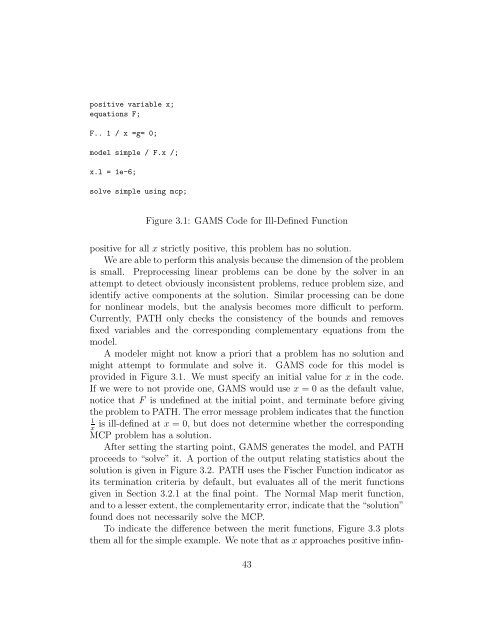GAMS/PATH User Guide Version 4.3
GAMS/PATH User Guide Version 4.3
GAMS/PATH User Guide Version 4.3
You also want an ePaper? Increase the reach of your titles
YUMPU automatically turns print PDFs into web optimized ePapers that Google loves.
positive variable x;<br />
equations F;<br />
F.. 1 / x =g= 0;<br />
model simple / F.x /;<br />
x.l = 1e-6;<br />
solve simple using mcp;<br />
Figure 3.1: <strong>GAMS</strong> Code for Ill-Defined Function<br />
positive for all x strictly positive, this problem has no solution.<br />
We are able to perform this analysis because the dimension of the problem<br />
is small. Preprocessing linear problems can be done by the solver in an<br />
attempt to detect obviously inconsistent problems, reduce problem size, and<br />
identify active components at the solution. Similar processing can be done<br />
for nonlinear models, but the analysis becomes more difficult to perform.<br />
Currently, <strong>PATH</strong> only checks the consistency of the bounds and removes<br />
fixed variables and the corresponding complementary equations from the<br />
model.<br />
A modeler might not know a priori that a problem has no solution and<br />
might attempt to formulate and solve it. <strong>GAMS</strong> code for this model is<br />
provided in Figure 3.1. We must specify an initial value for x in the code.<br />
If we were to not provide one, <strong>GAMS</strong> would use x = 0 as the default value,<br />
notice that F is undefined at the initial point, and terminate before giving<br />
the problem to <strong>PATH</strong>. The error message problem indicates that the function<br />
1<br />
x<br />
is ill-defined at x = 0, but does not determine whether the corresponding<br />
MCP problem has a solution.<br />
After setting the starting point, <strong>GAMS</strong> generates the model, and <strong>PATH</strong><br />
proceeds to “solve” it. A portion of the output relating statistics about the<br />
solution is given in Figure 3.2. <strong>PATH</strong> uses the Fischer Function indicator as<br />
its termination criteria by default, but evaluates all of the merit functions<br />
given in Section 3.2.1 at the final point. The Normal Map merit function,<br />
and to a lesser extent, the complementarity error, indicate that the “solution”<br />
found does not necessarily solve the MCP.<br />
To indicate the difference between the merit functions, Figure 3.3 plots<br />
them all for the simple example. We note that as x approaches positive infin-<br />
43

















